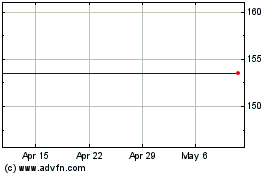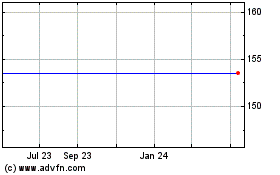By Bradley Olson and Alison Sider
U.S. refiners, which posted robust profits the last 18 months
even as other parts of the oil business were racked by low crude
prices, finally saw their roll come to a halt in the first
quarter.
Many refining businesses reported earnings for the period that
were down roughly by half from a year earlier. That decline helped
sour results for oil giants such as Exxon Mobil Corp., which has
counted on refining to offset profit declines in energy production,
and for Valero Energy Corp., the world's largest stand-alone
refiner by output, which on Tuesday reported its lowest
first-quarter profit in four years.
"The first quarter presented us with challenging markets, with
gasoline and diesel margins under pressure," said Valero Chief
Executive Joe Gorder.
Two trends have helped upend the refining boom: U.S. crude is no
longer trading at a steep discount compared with oil from other
parts of the world. And American exports of gasoline and diesel are
pushing into increasingly well-supplied foreign markets.
For years, U.S. refiners benefited because a bounty of oil
unlocked by shale exploration was essentially landlocked in the
country due to a ban on most crude exports, creating a glut that
pushed down prices compared with barrels in Africa and the Middle
East.
That allowed U.S. refiners to turn oil into gasoline, diesel and
other products more cheaply than some competitors, and enhanced
their ability to export the fuels to foreign markets. Between 2010
and 2015, U.S. exports of gasoline and other fuels rose 38% to 2.8
million barrels a day, helping to reduce the nation's trade
imbalance.
Now that U.S. oil production is falling and the country allows
crude exports, that advantage has significantly diminished. Once as
high as $25 a barrel in 2011, the difference between U.S. and
international crude benchmark prices now sits at a little over $1 a
barrel today.
New pipelines also have further smoothed out regional price
differences that had benefited some American refiners by giving
them greater access to landlocked oil.
While refiners largely still make money, and are in better shape
than during the industry's most recent challenging times in 2009,
the lower returns illustrate how the price crash is finally
reaching a piece of the business that had been insulated.
"When prices come down as they have, refining margins hold out
for a period of time, but that works its way through the system and
the pressure comes back on," said Richard Forrest, a partner at
consulting firm A.T. Kearney.
It is hard to overstate how good the refining business has been
in recent years. Since mid-2012, shortly after two companies spun
out their fuel processing units into stand-alone companies, the
four best-performing energy stocks on the S&P 500 index were
refiners.
All four companies -- including Valero, Tesoro Corp., Marathon
Petroleum Corp. and Phillips 66 -- more than doubled in value. Last
year, when average U.S. oil prices fell by almost half to about $45
a barrel, Valero shares rose 43%.
Exxon's global network of refineries has been a critical bulwark
against losses since oil prices began to tumble in the summer of
2014. That is the central rationale for the company's "integrated"
structure of tapping wells, shipping crude and processing it into
fuels and chemicals: When crude prices fall, refining will remain a
lucrative business.
Yet Exxon's profit from its refineries fell 46% to $906 million
in the first quarter. Chevron's fell 48%. The totals were still
enough to help keep Exxon profitable in the quarter, but Chevron
posted its second-straight quarterly loss, the first time that has
happened in at least two decades.
On Tuesday, Valero disclosed its earnings dropped nearly 49%, to
$495 million, from the first quarter of last year. Tesoro, which
has large operations on the West Coast, reports on Wednesday.
Along the Gulf Coast, home to more than half of the country's
refining capacity, per-barrel profit margins shrank from $10.30 on
average last year to $6.75 in the first three months of 2016,
according to refining consultants Turner, Mason & Co. Some
refiners in the Midwest cut production rates that quarter to work
off extra inventory.
Many analysts expect demand will come roaring back when U.S.
drivers emerge from winter malaise and take to the road for summer
trips. Refiners say they are already seeing signs of a coming
strong driving season. The U.S. Energy Information Administration
has predicted domestic gasoline demand will grow 1.4% this year
after rising 2.7% last year.
"Strong demand and too much crude is great for refiners," Wolfe
Research LLC analyst Paul Sankey wrote in a research note last
month. The caveat: "It has to be said we are dependent on driving
season showing up in a big way," he added.
But even if predictions for a profitable summer prove true,
refining mightn't be able to keep propping up earnings for
companies that both produce oil and consume it in plants that churn
out gasoline and diesel.
Drivers in the U.S. raced to buy gas-guzzling trucks and SUVs
last year when fuel prices first started to fall, helping to push
demand for gasoline up last year. But the average vehicle sold
today is significantly more efficient than just a few years ago,
according to the University of Michigan's Transportation Research
Institute, which tracks fuel economy.
For the past year and a half, low crude prices have encouraged
refiners to buy oil and produce more fuel than the world needs,
said Robert Campbell, head of oil products research at consultants
Energy Aspects. That has led to a buildup of fuel inventory
globally, which could cut into refining margins later this year as
crude prices start to recover.
"We'll go back to having an excess of refining capacity, which
was the problem prior to the fall in oil prices," he said.
--Douglas Kobin contributed to this article.
Write to Bradley Olson at Bradley.Olson@wsj.com and Alison Sider
at alison.sider@wsj.com
(END) Dow Jones Newswires
May 04, 2016 02:48 ET (06:48 GMT)
Copyright (c) 2016 Dow Jones & Company, Inc.
Andeavor (NYSE:ANDV)
Historical Stock Chart
From Mar 2024 to Apr 2024

Andeavor (NYSE:ANDV)
Historical Stock Chart
From Apr 2023 to Apr 2024
